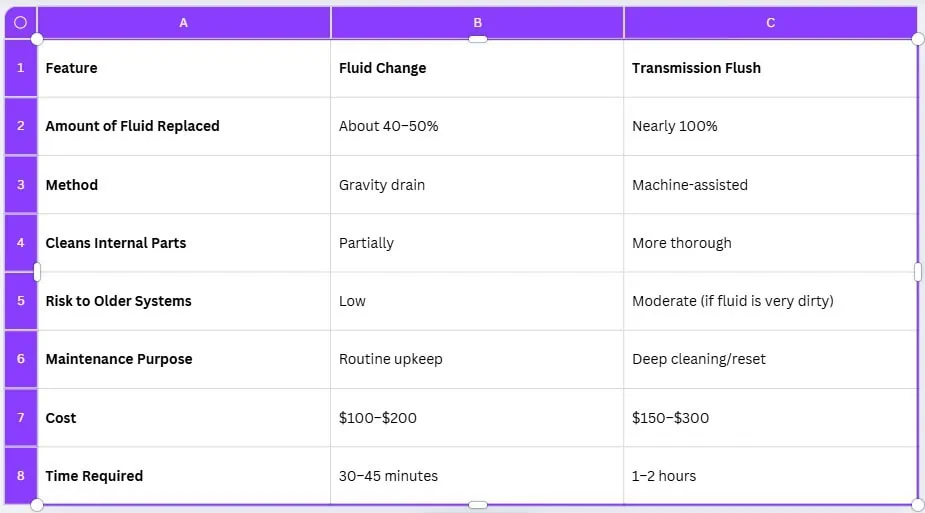When deciding between a transmission flush or fluid change, consider the specific needs of your vehicle.
When to Choose a Fluid Change
Opt for a transmission fluid change when:
- Your fluid is mildly discolored but not burnt
- Your car is under regular maintenance intervals (30,000–60,000 miles)
- Your vehicle has high mileage and has never had a flush
- You’re being cautious with an older transmission
This aligns with the transmission fluid change interval that most manufacturers recommend. It’s a low-risk, affordable way to keep your transmission working smoothly without stressing older seals or dislodging settled debris.
When to Choose a Flush
A transmission flush might be a better option when:
- Your fluid is black, thick, or smells burnt
- Shifting feels sluggish or rough
- You’ve never serviced your transmission in over 60,000 miles
- You regularly tow, haul, or drive in heavy traffic or hot climates
- You’re correcting performance issues caused by dirty fluid
Flushes clean the entire system and help restore responsiveness, if the transmission is still mechanically healthy. This is especially important in harsh driving conditions across North America.
Is Transmission Flush Necessary?
People often ask, “Is a transmission flush really necessary?” The answer depends on your vehicle’s condition, mileage, and how well you’ve stuck to a fluid change schedule.
When fluid is severely degraded or you need a full reset, a flush can be very beneficial. Just avoid doing it too late in the transmission’s life cycle.
Caution with Flushes
Flushing a neglected transmission with very dirty fluid can sometimes cause problems.
That’s because old debris might be helping seals maintain pressure. Dislodging it all at once could expose wear or trigger leaks. This is why some debate if flushing your transmission is good or bad.
When in doubt, start with a fluid change, monitor your vehicle, and consult a trusted mechanic before going for a full flush.
Long-Term Maintenance Tip
Regardless of which you choose, the key is consistency. Stick to a maintenance schedule, and always use the right ATF type.
Doing this will:
- Prevent internal wear
- Avoid overheating
- Extend the lifespan of your transmission
- Reduce long-term repair costs in both the US and Canadian climates
My Experience
Personally, I rotate between both. Every couple of years, I do a flush; in between, I stick to fluid changes. I use Amsoil Synthetic Multi-Vehicle ATF because it’s designed to handle heat, resist oxidation, and protect against internal wear—even under tough driving conditions.
That means I go farther between services and still get peace of mind. I’ve never had a transmission failure since switching.
No hype—just what’s worked for me.
Conclusion
Both services have their place:
- Choose a fluid change for regular maintenance or when playing it safe.
- Consider a flush if your transmission is due for a full clean or is exhibiting performance issues.
Either way, the quality of the fluid matters just as much as the service. High-performance synthetic ATF, like Amsoil, can significantly reduce wear and keep your transmission healthier for longer.
Frequently Asked Questions
How much does a transmission flush cost?
In the US and Canada, a transmission flush typically costs between $150 and $300. The price depends on your vehicle, location, and whether you’re using synthetic fluid. While it’s more expensive than a fluid change, it thoroughly cleans the entire system, offering more long-term value—especially if you’re experiencing shifting issues or high mileage.
What are the benefits of a transmission fluid change?
A fluid change helps:
- Replace old, worn-out ATF
- Improve gear shifting and reduce noise
- Cool transmission components more efficiently
- Remove small debris and slow down wear
- Extend transmission life when done regularly
It’s an affordable preventive measure that pays off in smoother performance and lower repair bills.
Is a transmission flush good or bad for older cars?
It depends on the condition of the transmission. If the fluid is very dirty and the transmission hasn’t been serviced for a long time, flushing could dislodge debris that was actually helping seals maintain pressure. In such cases, a fluid change is usually safer. For well-maintained transmissions, a flush can improve performance significantly.
Want more help? Check out:
1. Transmission Fluid Change: Everything You Need to Know
2. Transmission Flush: Is It Worth It?
3. Transmission Fluid Leaking: 8 Causes and Fixes
4. What Color is Transmission Fluid?
5. Automatic Transmission Fluid Types Explained

